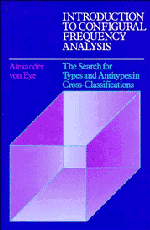 Introduction to Configural Frequency Analysis
Introduction to Configural Frequency Analysis Part I outlines the general problem and defines concepts of CFA. It presents statistical tests and gives an overview of CFA models. Part II introduces the reader to models and applications of CFA, describing the models in more detail. Each model has at least one data example. Part III is concerned with the analysis of longitudinal data. It offers solutions to problems with dependent data and the exponential increase in the number of cells of contingency tables when repeated observations are crossed. In addition, it shows how to decompose time series and to analyze treatment effects. The final part discusses CFA as a complement to log-linear modeling, and appropriate computer programs are presented.
My thanks are due to all those who supported my writing of this text. There is first Gustav A. Lienert who convinced me of the usefulness of CFA and who read and commented on the entire manuscript. Phil Wood and Connie Jones also read the entire manuscript and gave insightful comments. Richard Lerner and Mike Rovine provided encouragement and useful discussions of parts of the manuscript. An anonymous reviewer hired by the publishers read the manuscript very carefully and gave helpful comments and suggestions. Susan Milmoe and Laura Dobbins of Cambridge University Press were encouraging and supportive during all phases of the production of this book. Most of all, I am indebted to Donata, Maxi, Lise, and Juli for all their love.
To save this book to your Kindle, first ensure [email protected] is added to your Approved Personal Document E-mail List under your Personal Document Settings on the Manage Your Content and Devices page of your Amazon account. Then enter the ‘name’ part of your Kindle email address below. Find out more about saving to your Kindle.
Note you can select to save to either the @free.kindle.com or @kindle.com variations. ‘@free.kindle.com’ emails are free but can only be saved to your device when it is connected to wi-fi. ‘@kindle.com’ emails can be delivered even when you are not connected to wi-fi, but note that service fees apply.
Find out more about the Kindle Personal Document Service.
To save content items to your account, please confirm that you agree to abide by our usage policies. If this is the first time you use this feature, you will be asked to authorise Cambridge Core to connect with your account. Find out more about saving content to Dropbox.
To save content items to your account, please confirm that you agree to abide by our usage policies. If this is the first time you use this feature, you will be asked to authorise Cambridge Core to connect with your account. Find out more about saving content to Google Drive.